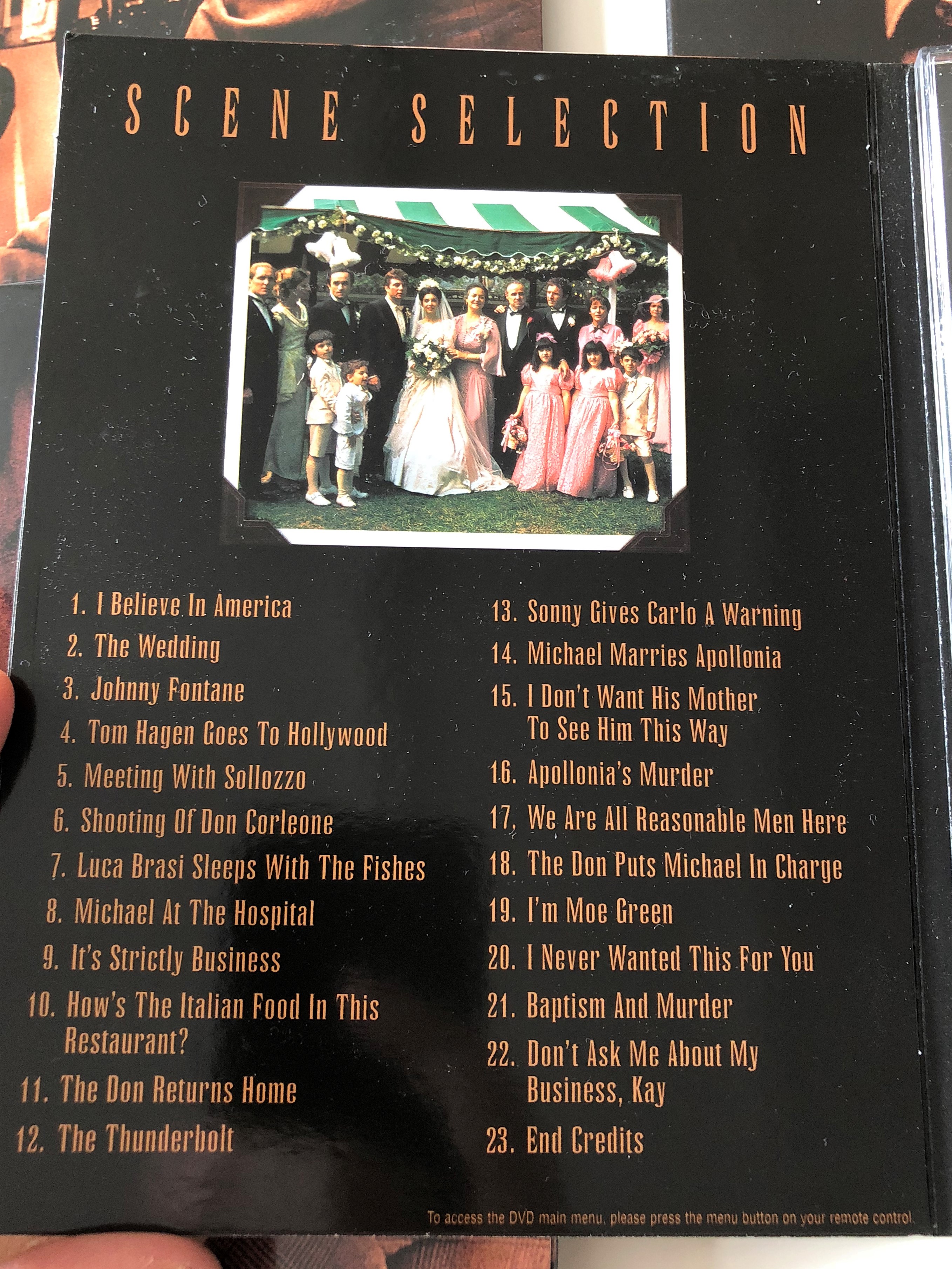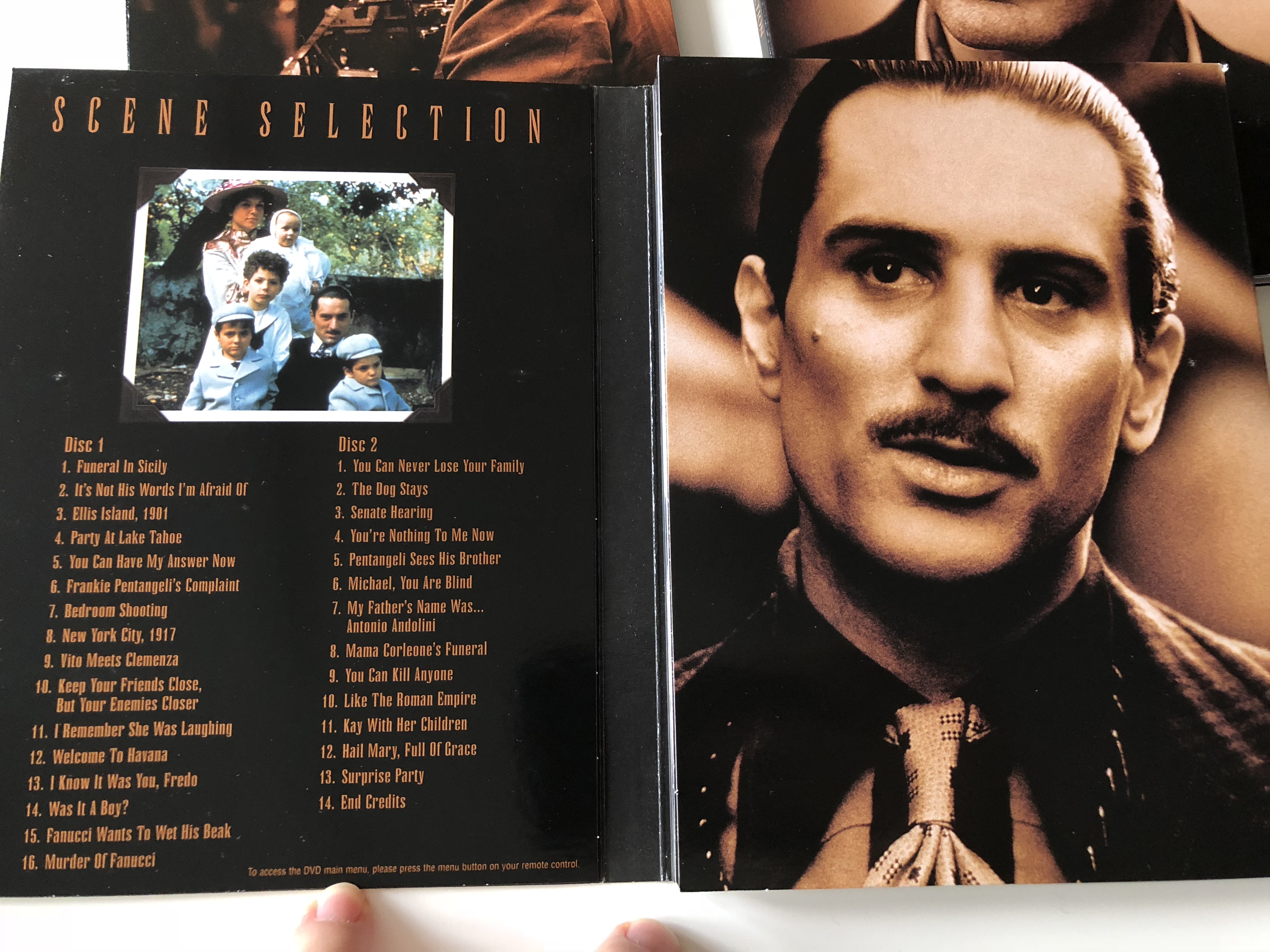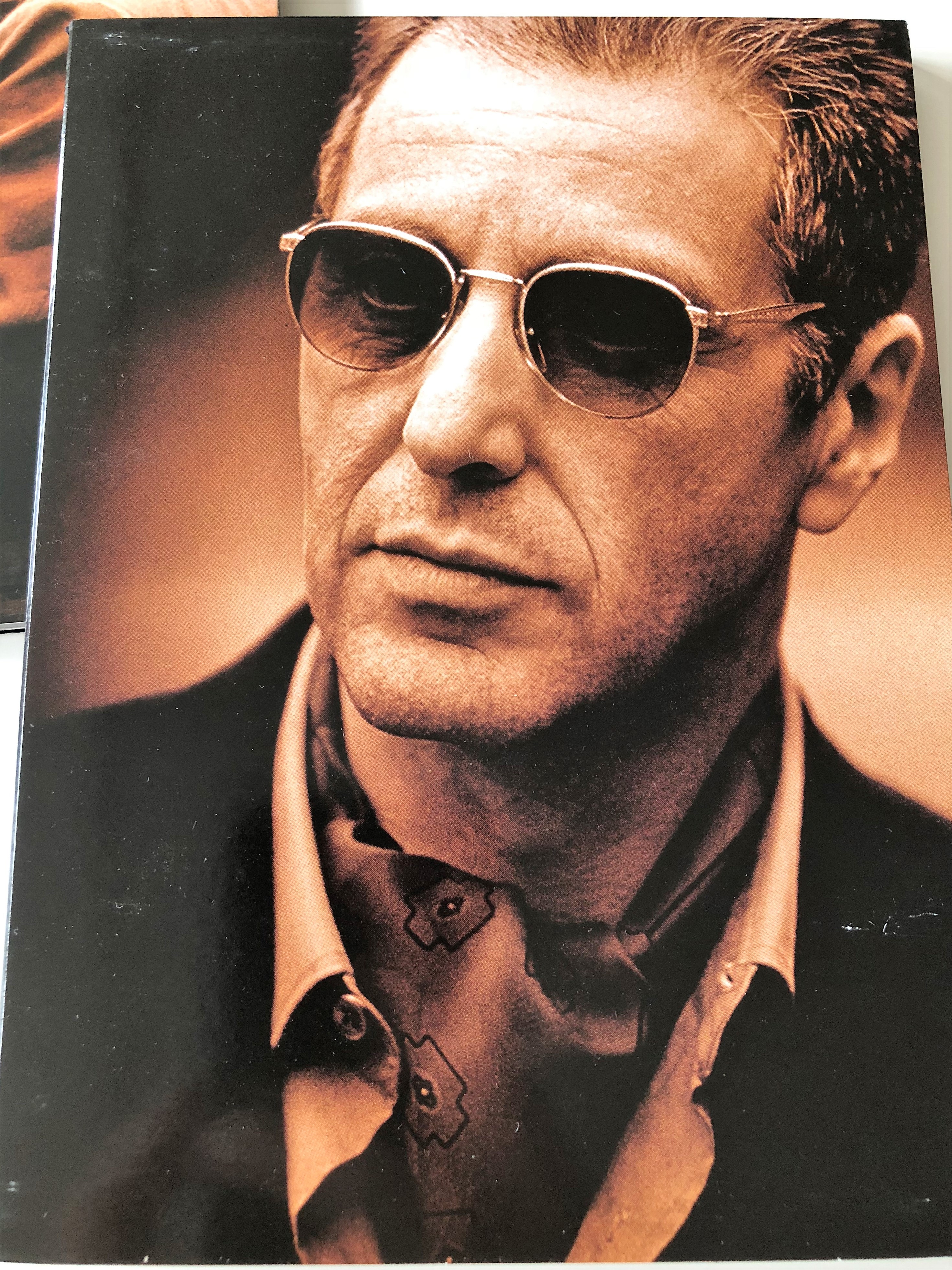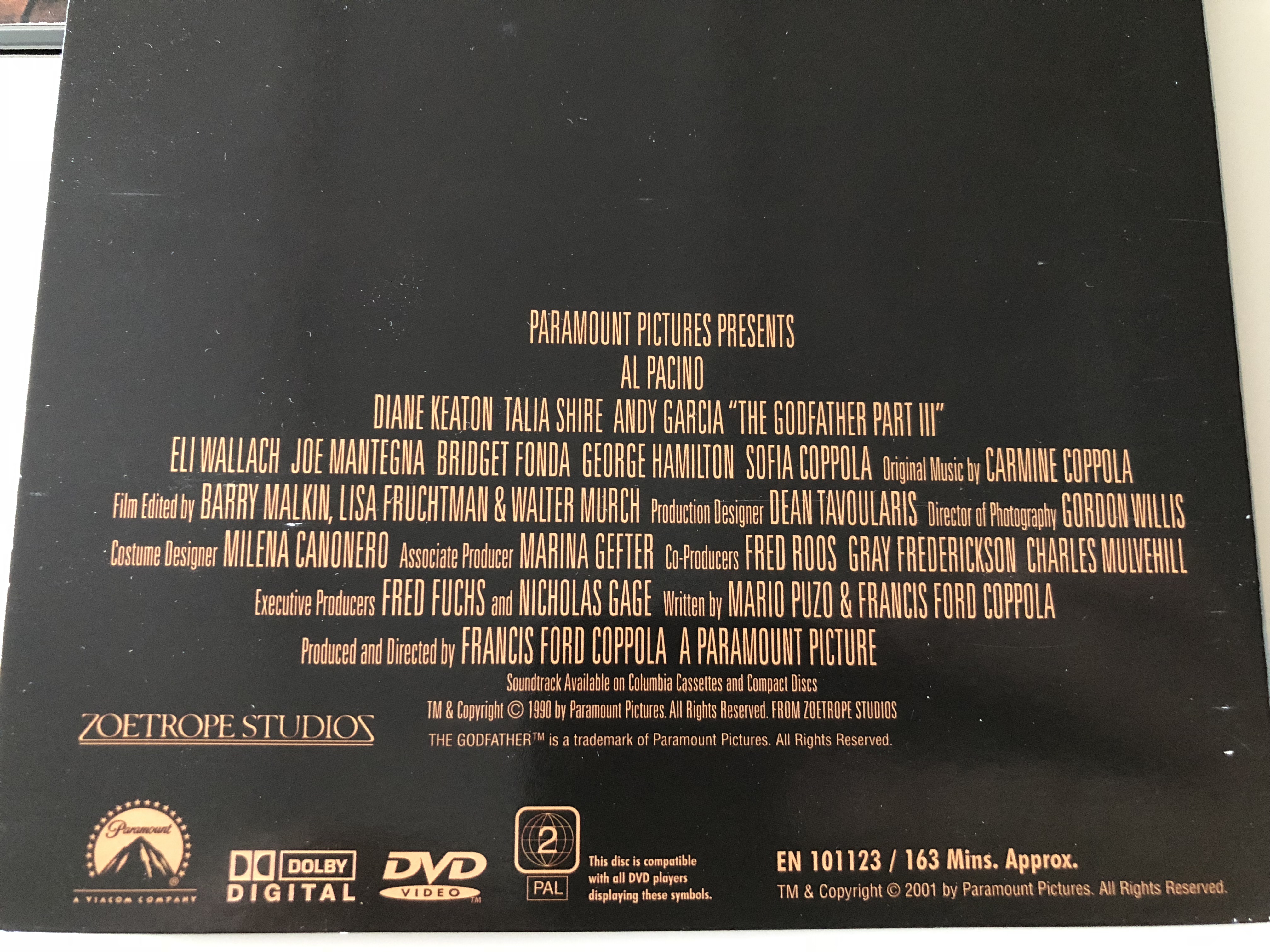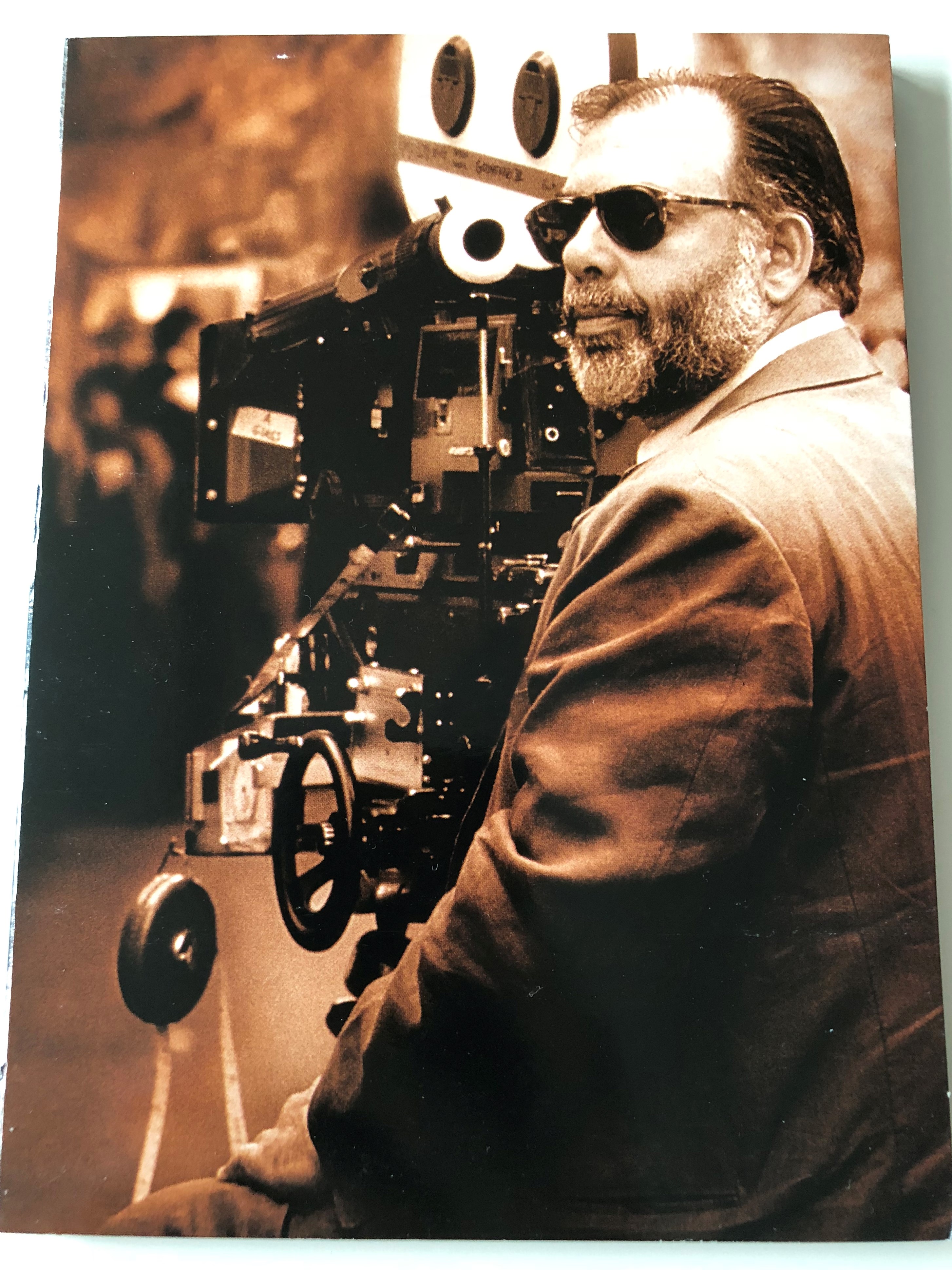Product Overview
The Godfather 5DVD Collection Collector's Edition Europe / Part 1, 2 & 3 with Special Features Disc / Directed by Francis Ford Coppola / Screenplay by Mario Puzo
UPC 5055025311155
MADE IN EUROPE
REGION 2 PAL DVD
DVD SET CONDITION: USED - VERY GOOD!!!
Audio: ENGLISH
Subtitles: English, Bulgarian, Czech, Hungarian, Icelandic, Polish, Romanian
Distributed by Paramount Home Entertainment
Extra Features are 187 minutes long!!!
The Godfather (1972)
The release of The Godfather in 1972 was a milestone in cinema. The near 3-hour-long epic, which chronicled the saga of the Corleone family, received overwhelmingly positive reviews from critics and fetched Coppola the Academy Award for Best Adapted Screenplay, which he shared with Mario Puzo and two Golden Globe Awards: for Best Director and Best Screenplay. However, Coppola faced several difficulties while filming The Godfather. He was not Paramount's first choice to direct the movie; Italian director Sergio Leone was initially offered the job, but declined in order to direct his own gangster opus, Once Upon a Time in America. Peter Bogdanovich was then approached but he also declined the offer and made What's Up, Doc? instead; Bogdanovich has often said that he would have cast Edward G. Robinson in the lead had he accepted the film. According to Robert Evans, head of Paramount Pictures at the time, Coppola also did not initially want to direct the film because he feared it would glorify the Mafia and violence and thus reflect poorly on his Sicilian and Italian heritage; on the other hand, Evans specifically wanted an Italian-American to direct the film because his research had shown that previous films about the Mafia that were directed by non-Italians had fared dismally at the box office and he wanted to, in his own words, "smell the spaghetti". When Coppola hit upon the idea of making it a metaphor for American capitalism, however, he eagerly agreed to take the helm.
There was disagreement between Paramount and Coppola on the issue of casting; Coppola stuck to his plan of casting Marlon Brando as Vito Corleone, though Paramount wanted either Ernest Borgnine or Danny Thomas. At one point, Coppola was told by the then-president of Paramount that "Marlon Brando will never appear in this motion picture". After pleading with the executives, Coppola was allowed to cast Brando only if he appeared in the film for much less salary than his previous films, perform a screen-test and put up a bond saying that he would not cause a delay in the production (as he had done on previous film sets). Coppola chose Brando over Ernest Borgnine on the basis of Brando's screen test, which also won over the Paramount leadership. Brando later won an Academy Award for his portrayal, which he refused to accept. Coppola would later recollect:
The Godfather was a very unappreciated movie when we were making it. They were very unhappy with it. They didn't like the cast. They didn't like the way I was shooting it. I was always on the verge of getting fired. So it was an extremely nightmarish experience. I had two little kids, and the third one was born during that. We lived in a little apartment, and I was basically frightened that they didn't like it. They had as much as said that, so when it was all over I wasn't at all confident that it was going to be successful, and that I'd ever get another job.
After it was released, the film received widespread praise. It went on to win multiple awards, including the Academy Award for Best Picture and the Academy Award for Best Adapted Screenplay for Coppola. The film routinely features at the top in various polls for the greatest movies ever. It has been selected for preservation in the United States National Film Registry. In addition, it was ranked third, behind Citizen Kane, and Casablanca on the initial AFI's 100 Years…100 Movies list by the American Film Institute. It was moved up to second when the list was published again, in 2008.
Director Stanley Kubrick believed that The Godfather was possibly the greatest movie ever made and had without question the best cast.
- Marlon Brando as Vito Corleone
- Al Pacino as Michael Corleone
- James Caan as Sonny Corleone
- Robert Duvall as Tom Hagen
- Diane Keaton as Kay Adams
- John Cazale as Fredo Corleone
- Talia Shire as Connie Corleone
- Gianni Russo as Carlo Rizzi
- Richard Castellano as Peter Clemenza
- Abe Vigoda as Salvatore Tessio
- Al Lettieri as Virgil "The Turk" Sollozzo
- Sterling Hayden as Captain Mark McCluskey
- Lenny Montana as Luca Brasi
- Richard Conte as Emilio Barzini
- Al Martino as Johnny Fontane
- John Marley as Jack Woltz
- Alex Rocco as Moe Greene
- Morgana King as Carmela Corleone
- Corrado Gaipa as Don Tommasino
- Franco Citti as Calò
- Angelo Infanti as Fabrizio
- Johnny Martino as Paulie Gatto
- Victor Rendina as Philip Tattaglia
- Tony Giorgio as Bruno Tattaglia
- Simonetta Stefanelli as Apollonia Vitelli-Corleone
- Richard Bright as Al Neri
The Godfather Part II (1974)
Coppola shot The Godfather Part II parallel to The Conversation and it was the last major American motion picture to be filmed in Technicolor. George Lucas commented on the film after its five-hour-long preview, telling Coppola: "You have two films. Take one away, it doesn't work", referring to the movie's portrayal of two parallel storylines; one of a young Vito Corleone and the other of his son Michael. In the director's commentary on the DVD edition of the film (released in 2002), Coppola states that this film was the first major motion picture to use "Part II" in its title. Paramount was initially opposed to his decision to name the movie The Godfather Part II. According to Coppola, the studio's objection stemmed from the belief that audiences would be reluctant to see a film with such a title, as the audience would supposedly believe that, having already seen The Godfather, there was little reason to see an addition to the original story. However, the success of The Godfather Part II began the Hollywood tradition of numbered sequels. The movie was released in 1974 and went on to receive tremendous critical acclaim, with many deeming it superior to its predecessor.[37] It was nominated for 11 Academy Awards and received 6 Oscars, including 3 for Coppola: Best Picture, Best Adapted Screenplay and Best Director.
The Godfather Part II is ranked as the #1 greatest movie of all time in TV Guide's "50 Best Movies of All Time"[38] and is ranked at #7 on Entertainment Weekly's list of the "100 Greatest Movies of All Time".[39] The film is also featured on movie critic Leonard Maltin's list of the "100 Must-See Films of the 20th Century",[40] as well as Roger Ebert's "Great Movies" list.[41] It was also featured on Sight & Sound's list of the ten greatest films of all time in 2002, ranking at #4.
Coppola was the third director to have two nominations for Best Picture in the same year. Victor Fleming was the first in 1939 with Gone with the Wind and The Wizard of Oz; Alfred Hitchcock repeated the feat the next year with Foreign Correspondent and Rebecca. Since Coppola, two other directors have done the same: Herbert Ross in 1977 with The Goodbye Girl and The Turning Point, and Steven Soderbergh in 2000 with Erin Brockovich and Traffic. Coppola, however, is the only one to have produced the pictures.
- Al Pacino as Michael Corleone
- Robert Duvall as Tom Hagen
- Diane Keaton as Kay Adams-Corleone
- Robert De Niro as Vito CorleoneJohn Cazale as Fredo Corleone
- Oreste Baldini as young Vito Corleone
- Talia Shire as Constanzia "Connie" Corleone
- Lee Strasberg as Hyman RothMichael V. Gazzo as Frank Pentangeli
- John Megna as young Hyman Roth
- Morgana King as Carmela CorleoneG. D. Spradlin as Senator Pat Geary
- Francesca De Sapio as young Carmela
- Richard Bright as Al Neri
- Tom Rosqui as Rocco Lampone
- Marianna Hill as Deanna Corleone
- Gastone Moschin as Don Fanucci
- Troy Donahue as Merle Johnson
- Joe Spinell as Willi Cicci
- Dominic Chianese as Johnny Ola
- Franco Corsaro as Genco AbbandandoBruno Kirby as young Peter Clemenza
- Frank Sivero as young Genco Abbandando
- John Aprea as young Salvatore Tessio
- Ezio Flagello as the impresario
- Kathleen Beller as Carla, daughter of the impresario and Genco's girlfriend
- Maria Carta as the mother of Vito Corleone
- Giuseppe Sillato as Don Francesco Ciccio
- Amerigo Tot as Michael's bodyguard
- Ivonne Coll as Yolanda
- Julian Voloshin as Sam Roth
- Fay Spain as Mrs. Roth
- Larry Guardino as Vito's uncle
- Carmine Caridi as Carmine Rosato
- Danny Aiello as Tony Rosato
- Leopoldo Trieste as Signor Roberto
- Salvatore Po as Vincenzo Pentangeli
- Harry Dean Stanton as FBI agent
- Roman Coppola as young Santino Corleone
The Godfather Part III (1990)
In 1990, he released the third and final chapter of The Godfather series: The Godfather Part III. While not as critically acclaimed as the first two films, it was still a box office success, earning $136 million against a budget of $54 million.[63] Some reviewers criticized the casting of Coppola's daughter Sofia, who had stepped into the leading role of Mary Corleone which had been abandoned by Winona Ryder just as filming began. Despite this, The Godfather Part III went on to gather 7 Academy Award nominations, including Best Director and Best Picture. The film failed to win any of these awards, the only film in the trilogy not to do so.
- Al Pacino as Michael Corleone
- Andy García as Vincent Corleone
- Diane Keaton as Kay Adams-Corleone
- Talia Shire as Connie Corleone
- Sofia Coppola as Mary Corleone
- Eli Wallach as Don Altobello
- George Hamilton as B. J. Harrison
- Joe Mantegna as Joey Zasa
- Richard Bright as Al Neri
- Bridget Fonda as Grace Hamilton
- Raf Vallone as Cardinal Lamberto
- Franc D'Ambrosio as Anthony Corleone
- Donal Donnelly as Archbishop Gilday
- Helmut Berger as Frederick Keinszig
- Don Novello as Dominic Abbandando
- John Savage as Father Andrew Hagen
- Mario Donatone as Mosca
- Vittorio Duse as Don Tommasino
- Enzo Robutti as Don Licio Lucchesi
- Al Martino as Johnny Fontane


